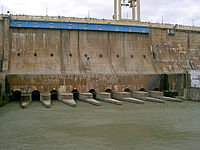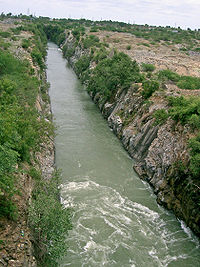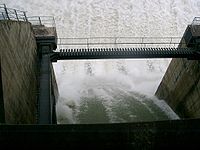
Nagarjuna Sagar Dam
Encyclopedia
Nagarjuna Sagar Dam is the world's largest masonry dam
built across Krishna River
in Nagarjuna Sagar, Nalgonda District
of Andhra Pradesh
, India
, between 1955 and 1967. The dam contains the Nagarjuna Sagar reservoir with a capacity of up to 11,472 million cubic metres. The dam is 490 ft (149.4 m). tall and 1.6 km long with 26 gates which are 42 ft (12.8 m). wide and 45 ft (13.7 m). tall.
Nagarjuna Sagar was the earliest in the series of large infrastructure projects initiated for the Green Revolution in India
; it also is one of the earliest multi-purpose irrigation and hydro-electric projects in India. The dam provides irrigation water to the Nalgonda District
, Prakasam District
, Khammam District
and Guntur
District
and electric power to the national grid.
paved way for the site identification, design and construction of the dam. Nagarjunasagar was the earliest in the series of "modern temples" taken up to usher in the Green Revolution in India
.
 Project construction was officially inaugurated by Prime Minister Jawaharlal Nehru
Project construction was officially inaugurated by Prime Minister Jawaharlal Nehru
, on 10 December 1955, and proceeded for the next twelve years. The reservoir water was released into the left and right bank canals by the then Prime Minister, Indira Gandhi
in 1967. Construction of the hydropower
plant followed, with generation increasing between 1978 and 1985, as additional units came into service.
The construction of the dam submerged an ancient Buddhist settlement, Nagarjunakonda, which was the capital of the Ikshvaku dynasty
in the 1st and 2nd centuries, the successors of the Satavahanas in the Eastern Deccan. Excavations here had yielded 30 Buddhist monasteries, as well as art works and inscriptions of great historical importance. In advance of the reservoir's flooding, monuments were dug up and relocated. Some were moved to Nagarjuna's Hill, now an island in the middle of the reservoir. Others were moved to the mainland.
 The project benefited farmers in the districts of Guntur
The project benefited farmers in the districts of Guntur
, Prakasam
, Krishna, Nalgonda
and Khammam. The right canal (a.k.a Jawahar canal) is 203 km long and irrigates 1.113 million acres (4,500 km²) of land. The left canal (a.k.a Lalbahadur Shastri canal) is 295 km long and irrigates 0.32 million acres (800 km²) of land in Nalgonda and Khammam districts of Telangana region. The project transformed the economy of above districts. 52 villages were submersed in water and 24000 people were affected. The relocation of the people was completed by 2007.
The dam is constructed on the border of Guntur and Nalgonda districts. The dam also provides drinking water to the Nalgonda town.

Masonry dam
Masonry dams are dams made out of masonry; mainly stone and brick. They are either the gravity or the arch type.The largest masonry dam of the world is Nagarjunasagar Dam in India....
built across Krishna River
Krishna River
The Krishna River , is one of the longest rivers in central-southern India, about . It is also referred to as Krishnaveni in its original nomenclature...
in Nagarjuna Sagar, Nalgonda District
Nalgonda district
Nalgonda / Nallagonda District is a district in Andhra Pradesh. It has a population of 3,483,648 of which 13.32% is urban as of 2001.-Etymology:Its name is derived from two Telugu words Nalla & Konda i.e...
of Andhra Pradesh
Andhra Pradesh
Andhra Pradesh , is one of the 28 states of India, situated on the southeastern coast of India. It is India's fourth largest state by area and fifth largest by population. Its capital and largest city by population is Hyderabad.The total GDP of Andhra Pradesh is $100 billion and is ranked third...
, India
India
India , officially the Republic of India , is a country in South Asia. It is the seventh-largest country by geographical area, the second-most populous country with over 1.2 billion people, and the most populous democracy in the world...
, between 1955 and 1967. The dam contains the Nagarjuna Sagar reservoir with a capacity of up to 11,472 million cubic metres. The dam is 490 ft (149.4 m). tall and 1.6 km long with 26 gates which are 42 ft (12.8 m). wide and 45 ft (13.7 m). tall.
Nagarjuna Sagar was the earliest in the series of large infrastructure projects initiated for the Green Revolution in India
Green Revolution in India
The introduction of high-yielding varieties of seeds and the increased use of fertilizers and irrigation are known collectively as the Green Revolution, which provided the increase in production needed to make India self-sufficient in food grains, thus improving agriculture in India...
; it also is one of the earliest multi-purpose irrigation and hydro-electric projects in India. The dam provides irrigation water to the Nalgonda District
Nalgonda district
Nalgonda / Nallagonda District is a district in Andhra Pradesh. It has a population of 3,483,648 of which 13.32% is urban as of 2001.-Etymology:Its name is derived from two Telugu words Nalla & Konda i.e...
, Prakasam District
Prakasam district
Prakasam District is an administrative district in the state of Andhra Pradesh, in India. The district headquarters is located at Ongole City...
, Khammam District
Khammam district
Khammam District is a district in Andhra Pradesh, India. It had a population of 2,565,412 of which 19.81% were urban as of 2001 census. Khammam town is the district headquarters. The present name of Khammam is derived from the old name Kammamet. Later it was called Khammam Mettu and subsequently...
and Guntur
Guntur
Guntur , is a city and a municipal corporation in the Indian state of Andhra Pradesh, located to the north and west of the Bay of Bengal. It is approximately to the south of the national capital, New Delhi and south east of state capital, Hyderabad. Guntur is the fourth largest city in Andhra...
District
Guntur district
Guntur district is located in Andhra Pradesh along the east coast of Bay of Bengal. The district has a coastline of around 100 kilometers. Guntur City is the largest city in the district and administrative center of Guntur District. The district is a major center for learning.-Etymology:There are...
and electric power to the national grid.
History
The proposal to construct a dam to use the excess waters of the Krishna river was sketched out by the British Engineers in 1903 on the supervision of Hyderabad Nizams. Since then, various competing sites in Siddeswaram, Hyderabad and Pulichintala were identified as the most suitable locations for the reservoirs. The perseverance of the Raja of MuktyalaRaja of Muktyala
The Muktyala Raja named Vasireddy Ramagopalakrishna Maheswara Prasad fondly called Projects Prasad belonged to the illustrious Vasireddy Clan and was noted for his efforts in infrastructure creation in India...
paved way for the site identification, design and construction of the dam. Nagarjunasagar was the earliest in the series of "modern temples" taken up to usher in the Green Revolution in India
Green Revolution in India
The introduction of high-yielding varieties of seeds and the increased use of fertilizers and irrigation are known collectively as the Green Revolution, which provided the increase in production needed to make India self-sufficient in food grains, thus improving agriculture in India...
.

Jawaharlal Nehru
Jawaharlal Nehru , often referred to with the epithet of Panditji, was an Indian statesman who became the first Prime Minister of independent India and became noted for his “neutralist” policies in foreign affairs. He was also one of the principal leaders of India’s independence movement in the...
, on 10 December 1955, and proceeded for the next twelve years. The reservoir water was released into the left and right bank canals by the then Prime Minister, Indira Gandhi
Indira Gandhi
Indira Priyadarshini Gandhara was an Indian politician who served as the third Prime Minister of India for three consecutive terms and a fourth term . She was assassinated by Sikh extremists...
in 1967. Construction of the hydropower
Hydropower
Hydropower, hydraulic power, hydrokinetic power or water power is power that is derived from the force or energy of falling water, which may be harnessed for useful purposes. Since ancient times, hydropower has been used for irrigation and the operation of various mechanical devices, such as...
plant followed, with generation increasing between 1978 and 1985, as additional units came into service.
The construction of the dam submerged an ancient Buddhist settlement, Nagarjunakonda, which was the capital of the Ikshvaku dynasty
Ikshvaku dynasty
The Ikshvaku dynasty, in Puranic literature, was a mythical dynasty founded by Ikshvaku, grandson of Vivasvan or Surya and son of Vaivasvata Manu. This dynasty is also known as . The important personalities belonging to this royal house are Harishchandra, Dilīpa, Sagara, Raghu, Rama and Prasenajit...
in the 1st and 2nd centuries, the successors of the Satavahanas in the Eastern Deccan. Excavations here had yielded 30 Buddhist monasteries, as well as art works and inscriptions of great historical importance. In advance of the reservoir's flooding, monuments were dug up and relocated. Some were moved to Nagarjuna's Hill, now an island in the middle of the reservoir. Others were moved to the mainland.
Effect of the project

Guntur district
Guntur district is located in Andhra Pradesh along the east coast of Bay of Bengal. The district has a coastline of around 100 kilometers. Guntur City is the largest city in the district and administrative center of Guntur District. The district is a major center for learning.-Etymology:There are...
, Prakasam
Prakasam district
Prakasam District is an administrative district in the state of Andhra Pradesh, in India. The district headquarters is located at Ongole City...
, Krishna, Nalgonda
Nalgonda district
Nalgonda / Nallagonda District is a district in Andhra Pradesh. It has a population of 3,483,648 of which 13.32% is urban as of 2001.-Etymology:Its name is derived from two Telugu words Nalla & Konda i.e...
and Khammam. The right canal (a.k.a Jawahar canal) is 203 km long and irrigates 1.113 million acres (4,500 km²) of land. The left canal (a.k.a Lalbahadur Shastri canal) is 295 km long and irrigates 0.32 million acres (800 km²) of land in Nalgonda and Khammam districts of Telangana region. The project transformed the economy of above districts. 52 villages were submersed in water and 24000 people were affected. The relocation of the people was completed by 2007.
Power Generation
The hydroelectric plant has a power generation capacity of 815.6 MW with 8 units (1x110 MW+7x100.8 MW). First unit was commissioned on 7 March 1978 and 8th unit on 24 December 1985. The right canal plant has a power generation capacity of 90 MW with 3 units of 30 MW each. The left canal plant has a power generation capacity of 60 MW with 2 units of 30 MW each.The dam is constructed on the border of Guntur and Nalgonda districts. The dam also provides drinking water to the Nalgonda town.
Statistics

- Catchment Area : 215000 km² (83012 sq mi)
- Masonry damMasonry damMasonry dams are dams made out of masonry; mainly stone and brick. They are either the gravity or the arch type.The largest masonry dam of the world is Nagarjunasagar Dam in India....
- SpillwaySpillwayA spillway is a structure used to provide the controlled release of flows from a dam or levee into a downstream area, typically being the river that was dammed. In the UK they may be known as overflow channels. Spillways release floods so that the water does not overtop and damage or even destroy...
of dam : 471 m - Non-over flow dam : 979 m
- Length of Masonry dam : 1450 m
- Maximum height : 125 m
- Spillway
- Earth dam
- Total Length of Earth dam : 3414 m
- Maximum height : 128 m

